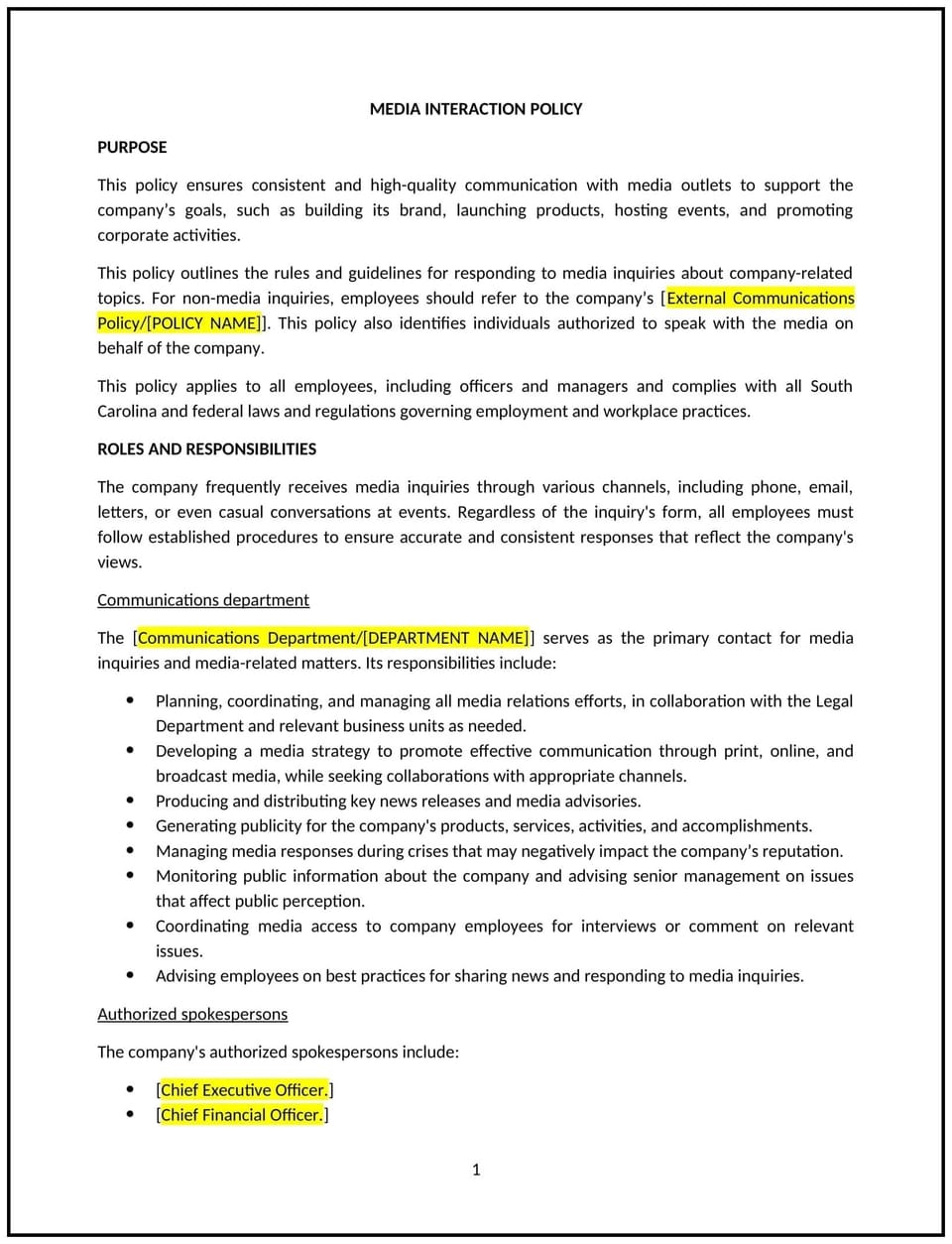Media relations policy (South Carolina): Free template

Media relations policy (South Carolina)
This media relations policy is designed to help South Carolina businesses establish guidelines for interacting with the media to ensure consistent and professional communication. It outlines procedures for responding to media inquiries, issuing press releases, and managing public statements to protect the business’s reputation and brand image.
By adopting this policy, businesses can maintain control over their public narrative, avoid miscommunication, and align with general best practices for media engagement.
How to use this media relations policy (South Carolina)
- Define media interactions: Explain what constitutes media interactions, such as interviews, press releases, or social media engagement.
- Designate spokespersons: Identify authorized individuals, such as PR representatives or senior management, who can speak on behalf of the business.
- Establish approval processes: Provide steps for reviewing and approving media communications, such as press releases or public statements.
- Address confidentiality: Outline procedures for protecting sensitive information when interacting with the media.
- Train employees: Educate staff on their responsibilities for adhering to the policy and redirecting media inquiries to authorized spokespersons.
- Review and update: Assess the policy annually to ensure it aligns with evolving business needs and media standards.
Benefits of using this media relations policy (South Carolina)
This policy offers several advantages for South Carolina businesses:
- Protects reputation: Ensures all media interactions reflect positively on the business.
- Maintains consistency: Provides a unified message across all media channels.
- Aligns with best practices: Offers a structured approach to managing media relations.
- Enhances professionalism: Demonstrates a commitment to clear, accurate, and respectful communication.
- Reduces risks: Minimizes the potential for miscommunication or reputational damage.
Tips for using this media relations policy (South Carolina)
- Communicate the policy: Share the policy with employees and include it in the employee handbook.
- Provide training: Educate staff on their responsibilities for adhering to the policy and redirecting media inquiries to authorized spokespersons.
- Monitor adherence: Regularly review media interactions to ensure compliance with the policy.
- Address issues promptly: Take corrective action if media communications violate the policy or harm the business’s reputation.
- Update regularly: Assess the policy annually to ensure it aligns with evolving business needs and media standards.
Q: How does this policy benefit businesses?
A: This policy protects reputation, maintains consistency, and aligns with best practices by establishing clear guidelines for media relations.
Q: Who is authorized to speak on behalf of the business?
A: Authorized spokespersons, such as PR representatives or senior management, should handle media interactions.
Q: How can employees respond to media inquiries?
A: Employees should redirect media inquiries to authorized spokespersons and avoid providing unofficial statements.
Q: What should businesses do if a media inquiry involves sensitive information?
A: Businesses should consult with legal or PR teams before responding and ensure confidentiality is maintained.
Q: How often should businesses review this policy?
A: Businesses should review the policy annually or as needed to ensure it aligns with evolving business needs and media standards.
This article contains general legal information and does not contain legal advice. Cobrief is not a law firm or a substitute for an attorney or law firm. The law is complex and changes often. For legal advice, please ask a lawyer.


